 |
Picks is a monthly sampling of Japan's art scene, offering short reviews of exhibitions at museums and galleries in recent weeks, with an emphasis on contemporary art by young artists. |
 |
 |
 |
1 December 2010 |
 |
| 1 | 2 | |
 |
|
 |
 |
|
|
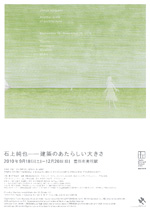 |
 |
 |
 |
| Junya Ishigami: Another scale of architecture |
| 18 September - 26 December 2010 |
Toyota Municipal Museum of Art
(Aichi) |
 |
| With the Golden Lion he won this year at the Venice Biennale and a solo show at Shiseido Gallery, Ishigami is the hot architect du jour. Filling the first gallery of his show at the Toyota, "Laminating Clouds" is composed of fine wires rising high in the air, interspersed with layers of thin cloth. Ostensibly an enlarged view of clouds as they appear to ants, it is free-standing and hence architecturally impressive. But the work in the last, largest gallery is the best of all: "Building Rain" is constructed of 54 0.9-millimeter columns supported by 0.02-millimeter wires. |
|
|
 |
|

|
 |
 |
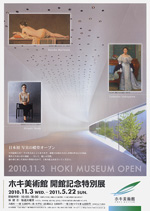 |
|
Hoki Museum Opening Exhibition |
| 3 November 2010 - 22 May 2011 |
Hoki Museum
(Chiba) |
 |
| A museum dedicated to realist painting, the Hoki opened in the suburbs of Chiba, east of Tokyo, on November 3. The architecture is daring: a jumble of several 100-meter-long, gently curving prisms, lying on their sides. Inside, stark white walls undulate and manipulate the visitor's field of vision. As an exhibition space, it's sublime. However, it is not exactly an optimum match for the realist works therein (by such artists as Tadahiko Nakayama, Hiroshi Noda, and Sousuke Morimoto). Instead of framed figurative paintings, these modernist white cubes (or tubes) would do a far better job as the setting for unframed abstract works. |
|
|
 |
 |
|
Transformation |
|
29 October 2010 - 30 January 2011
|
|
Museum of Contemporary Art Tokyo
(Tokyo) |
 |
| With metamorphosis as its theme, this show purports to explore the boundary between the human and the non-human. The high point is Jan Fabre's group of sculptures featuring heads modeled on his own, but with deer horns or rabbit ears. I personally like Sarah Sze's installation of agglomerations of plastic bottles, clothespins and other everyday objects, but it's not clear just what is being "transformed" there. |
|
|
|
|
|
|
|

|
 |
 |
|
|
|
|
|
 |
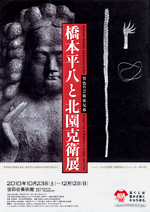 |
 |
 |
|
Hashimoto Heihachi and Kitasono Katue
|
|
23 October - 12 December 2010
|
Setagaya Art Museum
(Tokyo) |
 |
| The show's lengthy subtitle pretty much says it all: "Unusual pair of brothers, a sculptor and a poet, who explored pure forms of artistic expression." I'd heard of Kitasono, the poet, but I had no idea his older brother was a sculptor. Hashimoto produced subdued but profound works in wood and bronze, but died in 1935 at age 38. His younger brother by five years, Kitasono became Japan's preeminent avant-garde poet, but he was also a painter, designer, experimental filmmaker and photographer. Particularly unique is his "Plastic Poem" photo series, published in the postwar poetry magazine VOU. The exhibition succeeds admirably in placing the careers of the two brothers in a fresh context. |
|
|
|
|
|
|
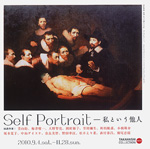 |
 |
|
Self Portrait: Others as Myself
|
|
4 September - 28 November 2010
|
Takahashi Collection Hibiya
(Tokyo) |
 |
Though formally an exhibition of self-portraits (perhaps timed with the concurrent Uffizi Self-Portrait Collection show at the Sonpo in mind?), this one includes works that extend beyond the confines of the genre: Daisuke Nakayama's piece resembles a suit of metal armor, while Satoshi Ono's painting combines various images, both figurative and abstract. All, however, seem a good fit to the subtitle, "Others as Myself." Also included are works by Yayoi Kusama, Yoshitomo Nara, and Yasumasa Morimura.
|
|
 |
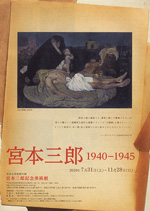 |
 |
| Saburo Miyamoto 1940-1945 |
| 31 July - 28 November 2010 |
Saburo Miyamoto Memorial Museum
(Tokyo) |
 |
| Even my own mother knew Miyamoto's name -- not as the rose-tinted artist of his later years, but as a heroic painter of battle scenes during the war. His sudden success as a war artist, however, was followed by concomitant hardship after Japan's defeat; unlike Leonard Foujita, Miyamoto had no prewar reputation to rebuild from. This show, at an annex devoted to Miyamoto at the Setagaya Museum, focuses on the years 1940-45, introducing not only his images of war but also prewar works painted in Europe as well as his postwar oeuvre. |
|
|
|
|
 |
|